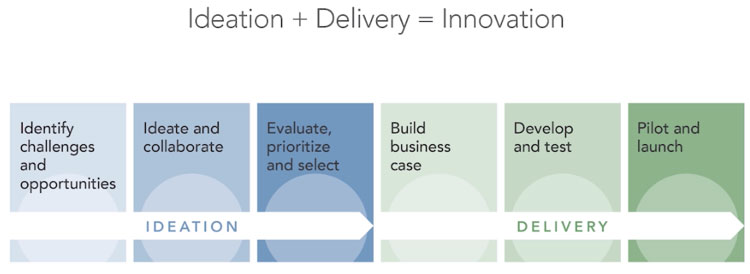
Recently, Apple announced it was ending its iconic iTunes app, President Trump surprised the market with new tariff threats against Mexico, and the U.S. government increased scrutiny over Google, Apple, and Facebook over possible antitrust violations. All of these market disruptions are poised to hurt some companies while presenting opportunities for others. What effect could they have on you? And are you prepared to drive innovation fast enough to reduce their impact or take advantage of them?
Market forces of this magnitude, including product and technology convergences and fundamental shifts in the workforce, are driving the need for innovation at hyper-speed. Companies are being forced to transform their business models, products, and employee cultures to keep up, which means accelerating and scaling innovation.
To stay ahead of the competition and succeed in the new digital era, organizations must connect strategy to delivery, which is much harder to do than ever before. It means fueling employee engagement, creating a culture of innovation, and leveraging automation to support the innovation pipeline.
According to Gartner, 40% of companies are experiencing business model changes driven by digital transformation. More than a third of companies that participated in a recent Planview study reported changes in their organizational structures, and updates to processes to complement their business models to grow revenue, enhance their customer experience, and improve their products and services.
Much of this change comes by way of digital transformation as companies invest more in technology to drive changes in the digital era. In our recent study, we found that 73% of companies are increasing their investments in technology. So, it’s a real issue to invest in technology that matters, but it’s an even bigger issue to make sure you’re picking the right technology.
The other big part is the way digital transformation is changing the way people work. There’s no one right way to do this whether it’s an iterative, Agile, Lean, or unstructured approach of bringing teams together. Your preference may vary on the makeup of your workforce, especially when you consider that four generations are now actively working together to drive innovation.
If all of this change and disruption is making your head spin, you’re not alone. Based on a Forrester report, 77% of organizations are currently battling change. But there is a path forward in three steps that we shared in a recent webinar: “Innovation @ Hyper-Speed,” which we’ll cover in greater detail. They include:
- Creating a culture of innovation
- Defining your innovation targets
- Connecting strategy to delivery
Let’s Start with a Culture of Innovation
When you talk to most business leaders, they’ll tell you innovation is king, but that there are not enough ideas coming from their employees. A recent study by McKinsey & Company, for example, showed that 84% of CEOs believe innovation is a top priority while another survey by the Corporate Executive Board shows 75% of executives are concerned with a deficit of good ideas.
Many business leaders say their companies aren’t moving fast enough in their quest for innovation. So speed is now a metric for success. Being too slow or not there at all with your competitors has real consequences, which you can prevent by increasing employee engagement through an active culture of innovation.
We witness companies making great strides all the time in improving employee engagement through Planview Planview IdeaPlace to future fit their organizations by democratizing innovation. This involves creating a process to help every employee be curious about and understand customer needs. And then help them establish confidence in delivering creative ideas that can touch any area of their business.
We apply this approach in a formula of ideation + delivery = innovation.

Define Your Innovation Targets
It may surprise you—probably not—that according to Accenture, 66% of CEOs don’t have a well-defined innovation strategy. They simply don’t have a strategy to launch it or structure it. They don’t know who is involved or their roles. There’s a need for innovation but no plan for how to get there. It’s like writer’s block—you know what you want to say, but you have no idea how to say it.
One of the easiest ways to overcome this hurdle is through an honest assessment of where you stand in your pursuit of innovation. This assessment is based on a five-scale maturity model broken down by people, processes, and technology/tools.
This tool will help you assess where you want to go and where to start. Think of this as three legs of a stool. One aspect might be more important or better grounded than the other. But there’s no support for achieving your goals if one of the three is missing.
Connect Strategy to Delivery
With this knowledge in hand, you can start driving an end-to-end innovation lifecycle covering product planning, product development, and product lifecycle through 10 steps:
- Develop an innovation strategy that drives the way you run your business.
- Foster and implement ideation to collect ideas and feed them into the front end of the funnel.
- Assess your capabilities management to know if you have what it takes to achieve your goals. Do you have the capabilities inside your organization to deliver innovation?
- And then look at your technology landscape to know if you have the right technology and understand the connection between different aspects of your technology.
- Prioritize your pipeline of what you need to do next. What innovation is most important. Which one is at the front of the line and what resources does it demand?
- Plan your resource capacity. Once you know what’s important, analyze and apply your resources to where they can have the most significant impact.
- Apply that knowledge of resources and priorities to develop a strategic roadmap and understand how all roadmaps work together: product, technology, and processes. And bring those along to align with your strategy.
- Apply financial planning to ensure the right projects are at the front of the line for funding. And understand the impact a product, project, or initiative has on your revenue.
- And then it’s about getting stuff done through collaboration and execution, whether through Lean or Agile and whatever works best for your employees.
- Finally, it’s reporting on your progress through data, analytics, and insights.
All of these steps should help you drive innovation at hyper-speed by defining innovation in your organization, increasing employee engagement, accessing your innovation maturity and helping you invest in the right processes, tools, and technology.
In addition to the webinar, Planview offers several resources at the end of the webinar to help you get started.



![How to Use Business Transformation to Drive Innovation in the Digital Era [Infographic]](https://blog.planview.com/wp-content/uploads/2019/02/Use-Business-Transformation-to-Drive-Innovation-in-the-Digital-Era.jpg)


